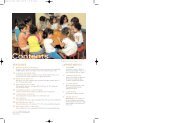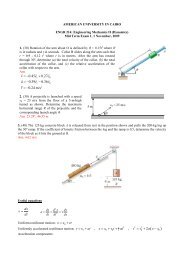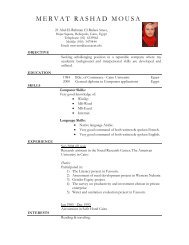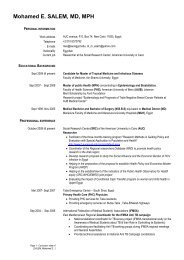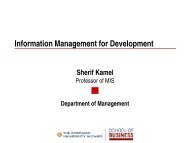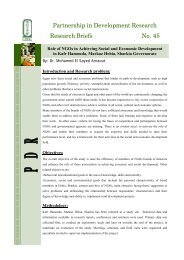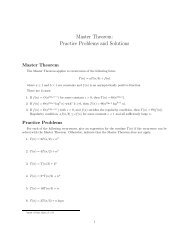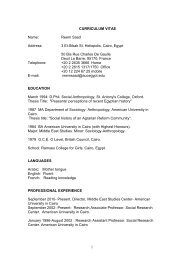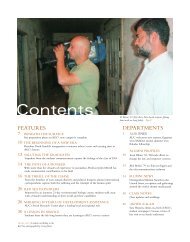computer mediated communication for learning and teaching
computer mediated communication for learning and teaching
computer mediated communication for learning and teaching
Create successful ePaper yourself
Turn your PDF publications into a flip-book with our unique Google optimized e-Paper software.
COMPUTER MEDIATED COMMUNICATION FOR LEARNING<br />
AND TEACHING: AN ANALYSIS<br />
Herb Thompson<br />
The American University in Cairo<br />
Cairo, Egypt<br />
herbt@aucegypt.edu<br />
Abstract<br />
By giving us greater control over in<strong>for</strong>mation, we, as teachers <strong>and</strong> learners, can be released from many<br />
of the daily mundane tasks in order to pursue more complex tasks, by using the <strong>computer</strong> as an analytical<br />
<strong>and</strong> synthetic medium. Yet, ironically, this leads many of us to see <strong>computer</strong> technology as a threat. Many<br />
of us who have spent our lives with face-to-face education have a similar view towards the <strong>computer</strong>, as<br />
did my gr<strong>and</strong>mother to the telephone. She wouldn't speak to anyone she couldn't see. In this paper we<br />
examine the relationship between <strong>computer</strong>-<strong>mediated</strong>-<strong>communication</strong> (c-m-c) <strong>and</strong> <strong>teaching</strong>/<strong>learning</strong>. We<br />
identify the strengths <strong>and</strong> weaknesses of asynchronous c-m-c, reflect on the relationships of students<br />
<strong>learning</strong> via <strong>computer</strong> mediation, <strong>and</strong> conclude with pedagogical insights as to the value of electronic,<br />
asynchronous <strong>communication</strong>.<br />
Keywords<br />
Educational technology, tertiary education, <strong>computer</strong> mediation, asynchronous <strong>communication</strong>, pedagogy<br />
1. INTRODUCTION<br />
Representational <strong>for</strong>mats of the previous 5,000 years have been digitalised. By giving us greater control<br />
over in<strong>for</strong>mation, we can be released to pursue more complex tasks, using the <strong>computer</strong> as an analytical<br />
<strong>and</strong> synthetic medium [24]. Yet, ironically, these phenomena lead many of us to see <strong>computer</strong> technology<br />
as a threat. Many of us who have spent our lives with face-to-face education have a similar view towards<br />
the <strong>computer</strong>, as did my gr<strong>and</strong>mother to the telephone. She wouldn't speak to anyone she couldn't see.<br />
Ahern <strong>and</strong> El-Hindi provided us with an important analytical case study of <strong>computer</strong>-<strong>mediated</strong> discussion<br />
from the perspective of teacher/facilitators when they argued [1], “implementing a change from the<br />
traditional classroom to one that values collaborative discourse in not simple”. Admittedly, there are those<br />
who take an extremely optimistic view seeing the end of classroom pedagogy <strong>and</strong> the professoriate, as<br />
aspiring students sit at home logging on <strong>and</strong> gathering whatever in<strong>for</strong>mation that is required to suit their<br />
own <strong>learning</strong> purposes [5] [18]. This, as might be expected is strongly challenged by a strongly asserted<br />
pessimistic view providing a view of the online Big Mac Degree providing second rate in<strong>for</strong>mation to<br />
isolated students who are ill-prepared to either use it or underst<strong>and</strong> it [25].<br />
In this paper a guarded optimistic view is taken that recognises the usefulness but accepts the caveats of<br />
<strong>computer</strong>-mediation in <strong>teaching</strong>/<strong>learning</strong>. The sections to follow begin with the consideration of <strong>computer</strong><br />
technology <strong>and</strong> <strong>teaching</strong>/<strong>learning</strong>. We then proceed to identify the strengths <strong>and</strong> weaknesses of <strong>computer</strong><strong>mediated</strong>-<strong>communication</strong><br />
as outlined in the literature. This is followed by reflections on participation,<br />
finishing with a summary that reviews the pedagogical insights gained from <strong>teaching</strong>/<strong>learning</strong> with<br />
<strong>computer</strong>s <strong>and</strong> the value of electronic, asynchronous <strong>communication</strong>. The definition of <strong>computer</strong><strong>mediated</strong>-<strong>learning</strong><br />
used herein, provided by Edwards <strong>and</strong> Clear [10], refers to “any <strong>for</strong>m of interpersonal<br />
<strong>communication</strong> that uses some <strong>for</strong>m of technology to transmit, store, annotate, or present in<strong>for</strong>mation,<br />
created by one or more participants”.<br />
2. COMPUTER TECHNOLOGY AND TEACHING/LEARNING<br />
Much of the published literature has focused on the benefits of the <strong>computer</strong> <strong>for</strong> instructional<br />
applications. These include quick <strong>and</strong> remote access to in<strong>for</strong>mation <strong>and</strong> instruction, convenience,
adaptability to change, speed of <strong>communication</strong>, the ability to reach large audiences, instant feedback,<br />
facilitation of group work, <strong>and</strong> cost savings [15] [28]. On the other h<strong>and</strong>, a significant literature,<br />
particularly amongst academic psychologists questions the expense <strong>and</strong> purpose of developing <strong>computer</strong>based<br />
<strong>learning</strong>. Some question whether the potential increment in student <strong>learning</strong> is worth the time <strong>and</strong><br />
trouble involved. Many authors have anecdotally discussed some of the shortcomings <strong>and</strong> obstacles of<br />
embracing the Internet in higher education settings. Such problems include lack of privacy issues, poor or<br />
limited interactions, technological difficulties (e.g., server failure, overloaded circuits, "dead" links),<br />
software limitations, increased time commitment (of faculty), limited faculty knowledge, training <strong>and</strong><br />
support, technological rather than content focus, isolation, <strong>and</strong> archival/retrieval concerns [9] [17] [33].<br />
Does <strong>computer</strong> technology simply allow us to achieve old goals more efficiently? Or can (should) it be<br />
used in a self-conscious manner to construct a social environment with a new morphology of<br />
interpersonal <strong>communication</strong>? The historically conditioned <strong>for</strong>ms of activity <strong>mediated</strong> through <strong>computer</strong>s<br />
must be studied <strong>for</strong> the qualitatively distinctive <strong>for</strong>ms of interaction that these artefacts af<strong>for</strong>d <strong>and</strong> the<br />
social arrangements that they help to constitute. One needs to consider the ‘effects’ of interacting in this<br />
medium in the entire system of social relations of which they are a part [31]. All of which begs the<br />
question: What are the strengths <strong>and</strong> weaknesses of <strong>computer</strong>-<strong>mediated</strong>-<strong>communication</strong>?<br />
3. STRENGTHS AND WEAKNESSES OF COMPUTER-MEDIATED-<br />
COMMUNICATION<br />
3.1 Strengths<br />
• The ability to think, study, participate <strong>and</strong> initiate conversation without the restrictions of time or<br />
place [4] [23].<br />
• The ability <strong>for</strong> reflection <strong>and</strong> thoughtful, asynchronous negotiation of meaning between members of<br />
a large group [7] [21]. This potential <strong>for</strong> collaboration is what connects <strong>computer</strong>-<strong>mediated</strong><strong>communication</strong><br />
to constructivist pedagogy [20].<br />
• Conversations may be archived <strong>for</strong> future reference including the ability to re-visit the full context of<br />
a topic [23].<br />
• The potential exists <strong>for</strong> greater equality of participation within the group given the reduction in<br />
recognisable, economic, social, <strong>and</strong> racial or gender distinction [11].<br />
3.2 Weaknesses<br />
• The ubiquitous complaint about lack of face-to-face contact, resulting in the loss of phatic functions<br />
that provide reassurance to both the speaker <strong>and</strong> listener [12].<br />
• Most of the messages are instructive rather than constructive or collaborative. This is probably not a<br />
weakness so much as a hurdle that must be leaped by all in the interest of "community".<br />
• Although electronic <strong>for</strong>a efficiently link those in need of in<strong>for</strong>mation with those that have it [8], the<br />
lack of sustained high-quality participation in <strong>for</strong>a discussion has been examined <strong>and</strong> seen to be a<br />
regularised phenomenon [34]. The "experience" [7], buttressed by personal involvement, is that there<br />
is no "rational" [13] [23] reason <strong>for</strong> someone to participate when they can "free ride" <strong>and</strong> enjoy the<br />
contributions of others, unless they have some altruistic concern about the survival of the <strong>for</strong>um. The<br />
relevant prediction is that message contributions will be generally undersupplied in all <strong>for</strong>a [29].<br />
There<strong>for</strong>e, both intuitively <strong>and</strong> experientially, “lurking” should come as no surprise.<br />
4. FURTHER REFLECTIONS ON MEDIATED COMMUNICATION
Reflection, although removed from the immediacy of the experience, leads one to thinking about other<br />
issues of immediate concern, that may be considered neither a strength nor weakness of the<br />
communicative mode.<br />
• While phatic mistakes are often made in face-to-face <strong>communication</strong>, one must take particular<br />
care not to offend other participants online, given the lack of symbolic or semiotic attributes<br />
(facial expressions, gestures, etc.) in <strong>computer</strong>-<strong>mediated</strong>-<strong>communication</strong>.<br />
• From a ‘constructivist’ perspective, the exchange of text-based messages seemingly encourages<br />
'active' [16] <strong>and</strong> 'self-directed' [23] <strong>learning</strong> since interaction is dependent on participants<br />
accessing the network frequently to follow conferences, read <strong>and</strong> comment on messages by<br />
others, <strong>and</strong> compose <strong>and</strong> submit their own contributions to conferences. Yet, even online there<br />
appears to be a carry-over from the classroom environment where all the students are facing<br />
<strong>for</strong>ward towards the “sage on the stage”.<br />
• Techno-frustration must be confronted. “Newcomers” easily become frustrated <strong>and</strong> fearful when<br />
the technology or administration isn't just right. Those who have used <strong>computer</strong>s develop a<br />
stronger sense of fatalism or a greater degree of patience, as well as the ability to think laterally<br />
about the technological problems that arise. But the numerous statements made by students<br />
suggesting sheer exasperation <strong>and</strong> a need <strong>for</strong> reassurance must be acknowledged.<br />
• Mark Twain pithily identified the underlying constituent of ego involvement in discourse when<br />
he said: "It is better to keep your mouth closed <strong>and</strong> let people think you are a fool than to open it<br />
<strong>and</strong> remove all doubt." In any case, “lurking”, a subject that has been well documented in the<br />
literature, is a continual frustration <strong>for</strong> an online facilitator. Even when the entire course depends<br />
on participation, both to make it work, <strong>and</strong> in terms of assessment, "lurking" remains.<br />
• Is the classroom experience one in which students are maximising their individual propensities<br />
<strong>for</strong> <strong>learning</strong>; or is the classroom a group-based, collaborative experience <strong>for</strong> mutual <strong>and</strong><br />
collective dialogue <strong>and</strong> interaction?<br />
• Clearly, interactive discussion is effective in assisting the <strong>learning</strong> process [6]. But it is vital not<br />
to be too active or "dominant" in conversational participation [13]. Herring, et. al [19] argue that<br />
men attempt to dominate <strong>computer</strong>-<strong>mediated</strong> interaction in much the same way they dominate<br />
F2F interaction: by “talking” more, taking authoritative stances in public discourse <strong>and</strong><br />
intimidating women into accommodation or silence.<br />
• The claim is regularly made in the literature that virtual interaction equalises <strong>communication</strong><br />
based on the assumption that status <strong>and</strong> gender cues are de-contextualized by the hypertext<br />
medium [14]. This does not appear to be entirely the case as shown in the research of Herring,<br />
et.al [19] into the defined features of men’s <strong>and</strong> women’s language on the basis of specific<br />
rhetorical styles ‘conventionally’ associated with each gender.<br />
• As Senge puts it, the success of any discussion depends “on the way a topic is developed<br />
systematically “which leads to the collective nature of thought” [32]. For a discussion to be<br />
effective, each member of the group must be able to establish common ground in the discussion.<br />
5. SUMMARY<br />
Computer technology unarguably increases access to education. Computer-<strong>mediated</strong>-<strong>communication</strong> is<br />
not meant to replace face-to-face <strong>communication</strong>. But like it or not it already has, <strong>and</strong> increasingly will,<br />
displace it. Although trite, it remains necessary to reiterate that no technological medium, on its own<br />
account, is likely to improve education in a significant way if only used to deliver in<strong>for</strong>mation. The key to<br />
promoting improved <strong>learning</strong> with <strong>computer</strong> technology depends on how effectively the medium is<br />
exploited in the <strong>teaching</strong> <strong>and</strong> <strong>learning</strong> situation [35]. Whether or not <strong>computer</strong>-<strong>mediated</strong> discussions are<br />
richer <strong>and</strong> more thoughtful depends more on knowledgeable social facilitation with respect to goals <strong>and</strong><br />
process, than it depends on the technology [30] [22]. Academics are not removed from the educational
process by <strong>computer</strong> technology. Their role simply shifts away from being deliverers of in<strong>for</strong>mation to<br />
being guides <strong>and</strong> creators of <strong>learning</strong> experiences [26], trans<strong>for</strong>ming both the classroom <strong>and</strong> education<br />
experience.<br />
The major characteristics of <strong>computer</strong>-<strong>mediated</strong>-<strong>communication</strong> <strong>and</strong> <strong>learning</strong> are the time <strong>and</strong> place<br />
independence, hyperlinking, <strong>and</strong> interactivity among various combinations of individuals [2] [36].<br />
According to Papert [27] the <strong>computer</strong> is particularly compatible with the way students now prefer to<br />
learn. The very 'interactivity' of discussion suggests that by providing relative anonymity <strong>and</strong> reduced<br />
personal identification, <strong>computer</strong>-<strong>mediated</strong>-<strong>communication</strong> may be more 'humanising' [37].<br />
Indicatively, the process of knowing requires significant ef<strong>for</strong>t on the part of both teachers <strong>and</strong> learners.<br />
The real issue is how to integrate the personal qualities of great <strong>teaching</strong> with the technological<br />
advantages of <strong>learning</strong> by <strong>computer</strong> [3]. Online education offers more than convenience. For all the<br />
mythology of the classroom, many students show up <strong>and</strong> snooze rather than learn. The <strong>computer</strong> <strong>for</strong>ces<br />
students to focus <strong>and</strong> to be active participants in <strong>learning</strong> rather than empty vessels into which academics<br />
try to pour their knowledge. It's very easy to attend a face-to-face class physically, yet not really be there<br />
mentally. However, without the necessary reflection, overzealous adoption of <strong>computer</strong> technology will<br />
not of itself strengthen the <strong>teaching</strong>/<strong>learning</strong> process.<br />
References<br />
[1] Ahern, T. & El-Hindi, A.E., Improving the instructional congruency of a <strong>computer</strong>-<strong>mediated</strong> smallgroup<br />
discussion: A case study in design <strong>and</strong> delivery, Journal of Research on Computing in Education,<br />
32(3), 2000., pp. 385-596<br />
[2] Althaus, S.L., Computer-<strong>mediated</strong> <strong>communication</strong> in the university classroom: An experiment with<br />
on-line discussions, Communication Education, 46, 1997, pp. 158-174<br />
[3] Applebome, P., Distance Learning: Education.com, The New York Times on the Web.<br />
http://www.nytimes.com/library/technology/99/04/biztech/articles/04onli.html, 4 April, 1999, Accessed 5<br />
-4-99<br />
[4] Brent, E., Computers in the undergraduate classroom Social Science Computer Review 17(2), 1999,<br />
pp. 162-175<br />
[5] Brown, J., Growing up Digital, Change, March/April, 2000, pp. 11-20. PDF version at<br />
http://www.aahe.org/change/digital.pdf Accessed: 20-5-05<br />
[6] Brown, J.S. <strong>and</strong> Duguid, P., The Social Life of In<strong>for</strong>mation, Chapter 5, Boston: Harvard Business<br />
School , 2000<br />
[7] Cifuentes, L., Murphy, K.L., Segur, R. <strong>and</strong> Kodali, S., Design Considerations <strong>for</strong> Computer<br />
Conferences, Research in Computing in Education, 30(2), 1997, pp. 177-201<br />
[8] Connolly, T., <strong>and</strong> Thorn, B.K., Discretionary databases: Theory, data, <strong>and</strong> implications, In Fulk, J.<br />
<strong>and</strong> Steinfield, C. (eds.), Organizations <strong>and</strong> Communication Technology, Newbury Park, Cali<strong>for</strong>nia:<br />
Sage, 1990, pp. 219-233<br />
[9] Daly, J.E., Hypertext links to <strong>learning</strong>: Roadblocks <strong>and</strong> obstacles along the in<strong>for</strong>mation super<br />
highway, Journal of Educational Technology Systems, 26, 1997/98, pp. 309-314<br />
[10] Edwards, M.A. & Clear, F., Supporting the Collaborative Learning of Practical Skills with<br />
Computer-Mediated Communications Technology, Educational Technology & Society, 4(1), 2001<br />
http://ifets.ieee.org/periodical/vol_1_2001/edwards.html, Accessed: 22-2-01.<br />
[11] Eurich-Fulcer, R. <strong>and</strong> Schofield, J.W., Wide-area networking in K-12 education: Issues shaping<br />
implementation <strong>and</strong> use, Computers <strong>and</strong> Education, 24(3), 1995, pp. 211-220.<br />
[12] Feenberg, A., The written world: On the theory <strong>and</strong> practice of <strong>computer</strong> conferencing, in Mason, R.<br />
<strong>and</strong> Kaye, A. (eds.), Mindweave: Communication, Computers <strong>and</strong> Distance Education, Ox<strong>for</strong>d:<br />
Pergamon Press, 1989, pp. 22-39<br />
[13] Friedman, Eric D., Haefele, L., Keating, K.M., Mullen, M., Patrick, M., Plotkin, D. & Strenski, E.,<br />
An Electronic Discussion List in an Undergraduate Writing Course, Computers <strong>and</strong> Education, 24(3),<br />
1995, pp. 191-201.<br />
[14] Graddol, D. & Swann, J., Gender Voices, Ox<strong>for</strong>d, Basil Blackwell, 1989<br />
[15] Hantula, D.A., The virtual industrial/organizational psychology class: Learning <strong>and</strong> <strong>teaching</strong> in<br />
cyberspace in three iterations, Behavior Research Methods, Instruments, & Computers, 30, 1998, pp. 205-<br />
216.
[16] Harasim, L.M. (ed.), Online education: Perspectives on a new environment, New York, Praeger,<br />
1990<br />
[17] Hardy, J.V., Teacher attitudes toward <strong>and</strong> knowledge of <strong>computer</strong> technology, Computers in the<br />
Schools, 14, 1998, pp. 119-136.<br />
[18] Herman, L. <strong>and</strong> M<strong>and</strong>ell. A., The Given <strong>and</strong> the Made: Authenticity <strong>and</strong> Nature in Virtual<br />
Education, First Monday, 5(10), October, 2000,<br />
http://firstmonday.org/issues/issue5_10/herman/index.html Accessed: 8-10-00<br />
[19] Herring, S., Johnson, D.A. & DiBenedetto, T., This Discussion is Going Too Far!, In Hall, K. <strong>and</strong><br />
Bucholtz, M. (eds.), Gender Articulated: Language <strong>and</strong> the Socially Constructed Self, New York,<br />
Routledge., 1995, pp. 66-96<br />
[20] Jonassen, D., Mayes, T. <strong>and</strong> McAleese, R., A Manifesto <strong>for</strong> a Constructivist Approach to<br />
Technology in Higher Education, In Duffy, T., Jonassen, D., <strong>and</strong> J. Lowyck (eds.), Designing<br />
constructivist <strong>learning</strong> environments. Heidelberg, Springer-Verlag, 1997,<br />
Accessed: 20-1-98.<br />
[21] Lewis, D.C., Treves, J.A. & Shaindlin, A.B., Making sense of academic cyberspace: Case study<br />
of <strong>and</strong> electronic classroom, College Teaching, 45(3), 1997, pp. 96-100.<br />
[22] McAteer, E., Tolmie, A., Duffy, C. & Corbett, J., Computer-<strong>mediated</strong> <strong>communication</strong> as <strong>learning</strong><br />
resource, Journal of Computer-Assisted Learning, 13, 1997, pp. 219-227.<br />
[23] Mason, R., Computer conferencing: A contribution to self-directed <strong>learning</strong>, British Journal of<br />
Educational Technology, 19(1), 1998, pp. 28-41.<br />
[24] Murray, J. H., Hamlet on the Holodeck, London, The Free Press, 1997<br />
[25] Noble, D.F., Digital Diploma Mills: The automation of higher education, First Monday 3(1) January,<br />
1998 http://firstmonday.org/issues3_1/noble/ Accessed: 12-9-98.<br />
[26] Owen, T., Wired writing: The writers in electronic residence program, In Mason, R. (ed.), Computer<br />
conferencing: The last word, Victoria, BC: Beach Holme, 1993, pp. 125-147<br />
[27] Papert, S., The Children’s Machine: Rethinking school in the age of the <strong>computer</strong>, New York: Basic<br />
Books, 1993<br />
[28] Pychyl, TA., Clarke, D., & Abarbanel, T., Computer-<strong>mediated</strong> group projects: Facilitating<br />
collaborative <strong>learning</strong> with the World Wide Web, Teaching of Psychology, 26, 1999, pp. 138-141<br />
[29] Rojo, A. <strong>and</strong> Ragsdale, R. G., A Process Perspective on Participation in Scholarly Electronic<br />
Forums, Science Communication 18(4), June, 1997, pp. 320-341.<br />
[30] Salomon, G., On the Nature of Pedagogic Computer Tools: The Case of the Writing Partner, In<br />
Lajoie, S.P. <strong>and</strong> Derry, S.J., Computers as Cognitive Tools, Hillsdale, N.J., Lawrence Erlbaum<br />
Associates, 1993, pp. 179-196<br />
[31] Scott, T., Cole, M. & Engel, M., Computers <strong>and</strong> Education: A Cultural Constructivist Perspective,<br />
Review of Research in Education, Washington, D.C., American Educational Research Association, 18,<br />
1992, pp. 191-251.<br />
[32] Senge, P M., The fifth discipline: The art <strong>and</strong> practice of the <strong>learning</strong> organization, New York,<br />
Doubleday, 1990<br />
[33] Sherman, R.C., Using the World Wide Web to teach everyday applications of social psychology,<br />
Teaching of Psychology, 25, 1998, pp. 212-216.<br />
[34] Stephen, T. <strong>and</strong> Harrison, T.M., Comserve: Moving the Communication Discipline Online, Journal<br />
of the American Society <strong>for</strong> In<strong>for</strong>mation Science 45, 1994, pp. 765-770.<br />
[35] Ward, M. & Newl<strong>and</strong>s, D., Use of the Web in Undergraduate Teaching, Computers <strong>and</strong> Education,<br />
31, 1998, pp.171-184.<br />
[36] Warschauer, M., Computer <strong>mediated</strong> collaborative <strong>learning</strong>: Theory <strong>and</strong> practice, The Modern<br />
Language Journal, 81(4), 1997, pp. 470-480<br />
[37] Weir, S., The <strong>computer</strong> in schools: machine as humaniser, Harvard Education Review, 59, 1989, pp.<br />
61-73.


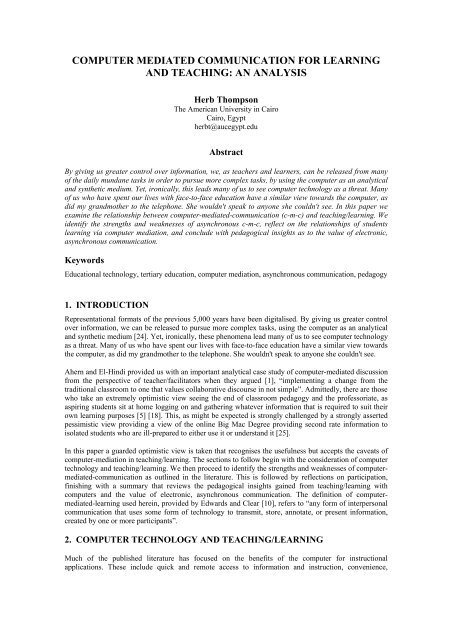
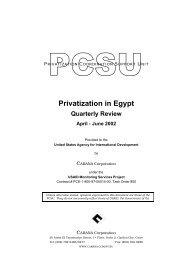
![Download entire catalog in pdf format [1.5MB] - The American ...](https://img.yumpu.com/51079239/1/190x260/download-entire-catalog-in-pdf-format-15mb-the-american-.jpg?quality=85)
